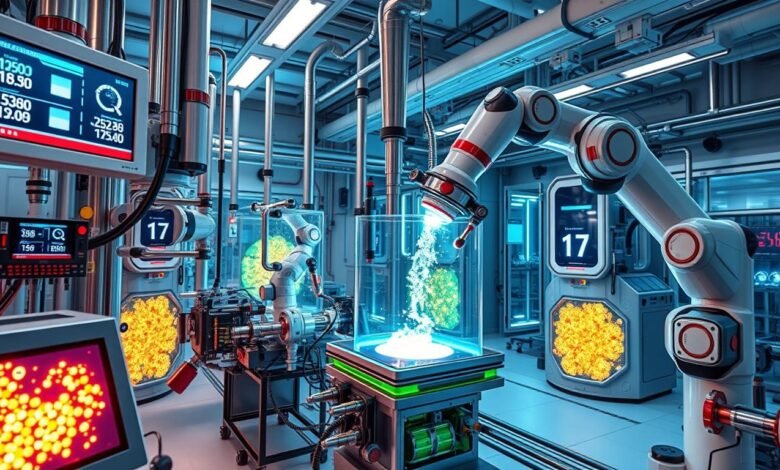Catalyst System Efficiency Below Threshold: Solutions

A recent EPA study uncovered alarming emissions data in the US. 7% of cars failed to meet federal emission standards. The P0420 or P0430 codes caused 68% of these failures.
These codes point to catalyst system inefficiency. We’ll explore the causes of these codes and their impact. We’ll also look at the role of oxygen sensors and catalytic converters.
Finally, we’ll discuss diagnosis methods and solutions. These apply to both automotive and industrial catalyst systems.
Key Takeaways
- The P0420 and P0430 codes indicate issues with the catalytic converter system efficiency, leading to decreased fuel economy and engine performance.
- Common causes include a faulty catalytic converter, malfunctioning oxygen sensors, exhaust leaks, and engine-related problems like misfiring or fuel-related issues.
- Proper diagnosis and troubleshooting, using tools like OBD scanners, can help identify the root cause and guide effective repairs.
- Ignoring these codes can result in significant damage to the catalytic converter and other components, making prompt attention crucial.
- Understanding the interplay between oxygen sensors and catalytic converters is essential for addressing catalyst system efficiency below threshold issues.
Understanding the P0420 and P0430 Codes
P0420 and P0430 OBD II codes signal issues with the catalytic converter. They appear when the rear oxygen sensor switches too much. This suggests the converter isn’t working well.
Several factors can trigger these codes. These include a failed converter, faulty sensors, or an exhaust leak. Circuit problems can also cause these issues.
What Causes the Codes?
A working catalytic converter creates different signals between oxygen sensors. The front and rear sensors should show distinct readings. Excessive switching of the rear sensor points to converter problems.
Interpreting the Codes
Technicians study oxygen sensor signals to diagnose the issue. They also check technical service bulletins for more information. This helps identify the root cause of the problem.
The analysis can reveal if it’s a faulty converter or sensor. It may also uncover other underlying issues causing the catalyst system efficiency below threshold problem.
“The P0420 and P0430 codes are essentially telling you that the catalytic converter is not functioning as efficiently as it should be.”
Grasping these OBD II codes is crucial for proper diagnosis. It’s the first step in fixing the catalyst system efficiency problem.
The Role of Oxygen Sensors and Catalytic Converters
How Oxygen Sensors and Catalytic Converters Work Together
Oxygen sensors and catalytic converters are vital for vehicle emissions control. They work together to ensure efficient combustion and reduce harmful exhaust emissions. These components help keep our air clean and our engines running smoothly.
A well-functioning catalytic converter causes the front oxygen sensor to switch rapidly. This happens as the engine adjusts the air-fuel mix for ideal combustion. The rear sensor, watching the converter’s performance, should show a steady signal.
Similar signals from both sensors may indicate a faulty catalytic converter. This could lead to higher emissions and lower fuel economy. It’s important to address these issues promptly.
| Component | Typical Efficiency Threshold | Normal Voltage Range | Exhaust Gas Temperature Range |
|---|---|---|---|
| Catalytic Converter | Over 95% | N/A | 300°C to 900°C (572°F to 1652°F) |
| Oxygen Sensors | N/A | 0.1V to 0.9V | N/A |
The engine control module (ECM) checks the oxygen sensor signals to assess converter efficiency. If efficiency drops too low, the Malfunction Indicator Light (MIL) turns on. This alerts drivers to potential issues needing diagnosis and repair.
Catalyst System Efficiency Below Threshold
The P0420 or P0430 code signals an issue with your car’s emissions control system. It shows that the catalytic converter isn’t working properly. This means pollutants aren’t being converted into less harmful substances effectively.
Various factors can trigger this code. These include a failed catalytic converter or faulty oxygen sensors. Other problems within the emissions control system may also cause it.
Proper diagnosis is key to fixing the root cause. This will restore your vehicle’s catalyst system efficiency. It also ensures compliance with environmental regulations.
- Code P0420 appeared indicating a catalyst system efficiency below threshold.
- A user reported the check engine light came on about 30 miles after resetting the code.
- One user mentioned needing to replace both oxygen sensors that ultimately resulted in the check engine light not reappearing after 55 miles.
- Replacement of the catalytic converter due to rust was successful in resolving the issue in one case for less than $200.
Addressing this code promptly is vital for your car’s health. It maintains performance and emissions control. Quick action also ensures compliance with environmental rules.
Diagnosing the Catalyst System Efficiency Below Threshold
Identifying the root cause of low catalyst system efficiency requires a systematic approach. Start by closely monitoring oxygen sensor signals. Analyze data from front and rear sensors to detect discrepancies in catalytic converter performance.
Check for technical service bulletins (TSBs) from the manufacturer. These provide insights into known issues and recommended diagnostic steps. TSBs may include updates to emissions software or trigger points for P0420 and P0430 codes.
| Diagnostic Step | Description |
|---|---|
| Monitor Oxygen Sensor Signals | Closely examine the signals from the front and rear oxygen sensors to identify any inconsistencies or abnormalities that could indicate a problem with the catalytic converter. |
| Check for Technical Service Bulletins | Review any manufacturer-issued technical service bulletins related to catalyst system efficiency issues, as they may provide guidance on updated diagnostic procedures or potential software fixes. |
Combining oxygen sensor monitoring with TSB checks helps technicians diagnose catalyst system efficiency issues. This comprehensive approach allows for developing an effective repair strategy.

Common Causes of Catalyst System Inefficiency
Your vehicle’s emissions control system is vital for environmental compliance and engine performance. Issues can impact the catalytic converter’s efficiency. Let’s explore the common causes of catalyst system inefficiency.
Failed Catalytic Converter
A failed converter is a main reason for catalyst system inefficiency. It can experience thermal damage or become poisoned by contaminants. Age-related deterioration can also wear out the converter over time.
When the converter can’t effectively convert harmful emissions, the system’s efficiency drops. This leads to increased pollution and potential engine problems.
Faulty Sensors or Circuit Problems
Oxygen sensors in the exhaust system provide crucial data to the engine control unit. They help maintain the optimal air-fuel mixture and monitor converter performance.
Malfunctioning sensors or electrical circuit issues can cause problems. They prevent accurate detection of emissions levels, reducing catalyst efficiency.
Exhaust Leaks
Leaks in the exhaust system before the catalytic converter affect efficiency. These leaks can skew oxygen sensor readings. This prevents proper management of the air-fuel mixture and converter monitoring.
Fixing exhaust leaks is crucial for maintaining emissions control system efficiency. Regular checks can help identify and address these issues early.
Understanding these common causes helps you address problems proactively. Regular maintenance and prompt diagnosis of trouble codes are key. They keep your car running clean and efficiently.
“A well-maintained catalytic converter is crucial for keeping your vehicle’s emissions in check and ensuring compliance with environmental regulations.”
Cleaning the Catalytic Converter with Fuel Additives
Is your vehicle’s catalyst system efficiency low? Fuel additives might offer a temporary fix for P0420 or P0430 codes. These products claim to clean the catalytic converter.
P1180 OXICAT is one such product. It works by driving at high RPMs to clean the converter. This may restore efficiency and clear emissions codes.
Remember, this is only a short-term solution. The real cause of converter degradation needs investigation and fixing.
- Modern OEM catalytic converters are designed to last roughly 10 years or 100,000 miles, but various factors can lead to premature failure.
- Lean or rich fuel-to-air mixtures, faulty oxygen sensors, and physical damage can all contribute to catalyst system inefficiency.
- While catalytic converter cleaning additives may provide a temporary boost in performance, they do not address the root cause of the problem.
Don’t rely on fuel additives long-term. Have a qualified technician diagnose the issue. They can determine the best fix for your vehicle.
Proper diagnosis might reveal the need for sensor replacement or exhaust repairs. In some cases, you may need a new catalytic converter.
Ignoring the real problem can harm your emissions control system. It might also cause issues with local regulations.
“Catalytic converter cleaning additives can provide a temporary fix, but they don’t address the root cause of the problem. A thorough diagnosis is essential to ensure the lasting health of your vehicle’s emissions control system.”

Understand the limits of catalytic converter cleaning additives. Take action to fix the true source of inefficiency. This approach keeps your vehicle running smoothly and reduces emissions.
Addressing the real issue helps avoid costly repairs later. It’s the smart way to maintain your vehicle’s performance and efficiency.
Replacing the Oxygen Sensors
Faulty oxygen sensors can cause catalyst system efficiency below threshold issues. Replacing these sensors often solves the problem. Both upstream and downstream sensors are crucial for engine management.
The OBDII system uses two oxygen sensors to check converter efficiency. It compares oxygen levels before and after the converter. If levels are off, it triggers P0420 or P0430 codes.
To fix emissions performance, replace the converter. But first, find and fix the root cause. This prevents early failure of the new converter.
Several factors can lead to converter failure. These include bad spark plugs, low cylinder compression, or faulty feedback systems. Proper sensor operation and air/fuel mixture are key for converter functionality.
In one case, a loose gas cap triggered the check engine light. This shows why thorough diagnostics are important before replacement.
| Potential Causes of P0420 Trouble Code | Symptoms |
|---|---|
|
|
Replacing faulty oxygen sensors can fix the emissions control system. This addresses the cause of P0420/P0430 codes. It improves catalyst system diagnostics and offers long-term solutions.
Catalyst System Efficiency Below Threshold: Diagnostic Tips
Low catalyst system efficiency requires a thorough approach. Technicians must check air, fuel, and spark factors. This helps find the root cause of the catalytic converter’s poor performance.
Air-Related Diagnostics
Air-fuel ratio is key for catalytic converter efficiency. Check for intake leaks that disrupt the air-fuel mix. Inspect the air intake system and look for leaks.
Ensure the correct air-fuel ratio is maintained. This step is crucial for optimal catalytic converter function.
Fuel-Related Diagnostics
Fuel system issues can hurt catalytic converter performance. Look for fuel delivery problems like pump failures or clogged injectors. Check fuel quality too.
Fixing these fuel-related factors can boost catalyst system efficiency. It’s an important step in the diagnostic process.
Spark-Related Diagnostics
The ignition system is vital for catalyst operation. Examine spark plugs, ignition coils, and other related parts. Make sure they work correctly.
Misfiring or ignition problems can harm the catalytic converter. They affect its ability to treat exhaust emissions effectively.
Addressing air, fuel, and spark factors helps solve efficiency issues. This approach restores the vehicle’s emissions control performance.
Conclusion
Catalyst system efficiency is vital for industrial applications. It affects process yields, product quality, and environmental compliance. Understanding P0420 and P0430 codes helps operators optimize their systems and boost efficiency.
This article provides a framework for addressing catalyst system challenges. It covers diagnostics and repair options for common efficiency issues. These include failed converters, faulty sensors, and exhaust leaks.
Maintaining catalyst efficiency goes beyond compliance. It drives optimization and improves industrial processes. It also reduces emissions and supports sustainability efforts.
By following these steps, industrial professionals can ensure peak performance. This leads to optimal results and minimized environmental impact. Ultimately, it contributes to a more sustainable future for industrial operations.
FAQ
What are the P0420 and P0430 codes?
P0420 and P0430 codes indicate catalytic converter inefficiency. They’re triggered when the rear oxygen sensor switches more than expected.
What causes the P0420 and P0430 codes?
These codes can result from a failing catalytic converter. Other causes include faulty sensors, circuit problems, or exhaust leaks.
How do oxygen sensors and catalytic converters work together?
The front oxygen sensor shows rapid signal switching. Meanwhile, the rear sensor displays a stable signal when the converter works well.
This happens as the converter stores and releases oxygen. It maintains the catalytic reaction for efficient pollutant conversion.
What is the catalyst system efficiency below threshold issue?
This issue occurs when the catalytic converter isn’t working properly. The vehicle’s computer detects ineffective conversion of pollutants into less harmful substances.
How can technicians diagnose the cause of the catalyst system efficiency below threshold issue?
Technicians should monitor oxygen sensor signals for discrepancies. They should check for differences between front and rear sensors.
It’s also important to review manufacturer-issued technical service bulletins. These can provide valuable insights for diagnosis.
What are the most common causes of catalyst system inefficiency?
Common causes include a failed catalytic converter. Faulty oxygen sensors, circuit problems, and exhaust leaks can also lead to inefficiency.
Can fuel additives help clean the catalytic converter?
Yes, some additives like P1180 OXICAT can temporarily improve a clogged converter. However, this is not a permanent fix.
It’s crucial to investigate and address the underlying cause. This will prevent future converter degradation.
How can replacing the oxygen sensors help resolve the catalyst system efficiency below threshold issue?
New oxygen sensors can fix P0420/P0430 codes. These sensors are vital for the closed-loop engine management system.
Proper sensor function ensures efficient catalytic converter operation. This helps maintain optimal engine performance and emissions control.
What diagnostic factors should technicians consider when addressing the catalyst system efficiency below threshold issue?
Technicians should examine air, fuel, and spark-related factors. They should check for intake leaks and fuel delivery problems.
Ignition system issues also need attention. These factors can significantly impact the catalytic converter’s performance.





